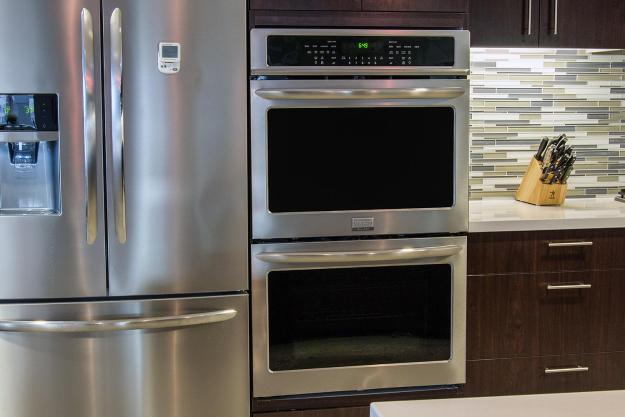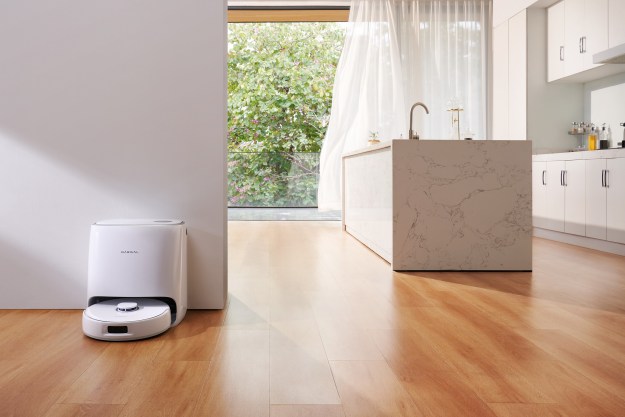
“The beautiful and featured-packed Frigidaire Gallery Series will make convection cooking easy – and turn your kitchen into a showroom.”
- Attractive
- Spacious
- Lots of rack options
- Feature-packed
- Temperature issues
- Preheat not as fast as promised
A double oven is dream come true for the busy baker or prolific chef. You can have a roast going in the upper oven, while the lower oven bakes your cookies to a golden brown. The only problem: trying not to spoil your appetite with cookies as the meat roasts to perfection.
Frigidaire’s Gallery Series double electric wall oven looks spiffy and is easy to use, and you should have no trouble performing two tasks simultaneously, provided you have the patience to wait for the ovens to get to the right temperature. With its convection fans, it’s possible to cook multiple items in the same oven (which means even more cookies).
Ranging from $1,798 to the suggested retail price of $2,699, the Frigidaire is pricey but by no means the most expensive double oven on the market. Read on to see if it will warm your heart or leave you cold.
Double duty
Not only is the Frigidaire Gallery Series a double oven with two equal-sized oven spaces, it has both traditional and convection settings; the double oven uses “true convection,” which adds a heating element to the fan. This heats the air circulating around the food, creating a more uniform temperature and cooking food more quickly and at a lower temperature.

If you’re not comfortable with convection cooking — conventional (or is that convectional?) wisdom suggests dropping the temperature by 25 degrees Fahrenheit and reducing the cooking time by 25 percent — the Frigidaire makes things easy on you. For one thing, you can stick to traditional baking or use the “Convect Convert” setting. Simply pushing that button and keying in the temperature indicated on your recipe will automatically reduce the oven’s temperature to the optimal convection setting. Use this in conjunction with the “Bake Time” feature, and the oven will automatically shut off three-quarters of the way through the keyed-in time listed in your recipe. Basically, it’s convection-virgin proof.
The screen-ing process
In case you can’t tell from the previous paragraph, this oven has lots of settings. The LCD screen is a bit crowded, but because the controls for the top oven are on the right and the ones for the bottom are on the left, it reduces the likelihood you’ll be pushing buttons for the wrong oven. But be warned: Pressing the “Off” button on the left side will still shut down the lower oven if the upper oven isn’t going.
The LCD screen is a bit crowded.
There’s also a lot of information packed onto the LCD. Indicators remind you that you’re working with the upper or lower oven; as you preheat and prepare, the display changes as the temperature climbs to your preferred setting. And a whirling-fan icon shows when you’re using the convection option. There’s only one timer, however, so if you have both ovens going, you’ll need another device to keep track of cooking time.
The panel is intuitive, but we must admit there’s still a few things that baffle us. During the preheating phase, a red line sometimes appears above or below the fan icon, whether or not you’re using the convection setting. We scoured the manual but couldn’t find an explanation for these mysterious icons. Illuminati?
That was fast… or was it?
Frigidaire boasts that its “Quick Preheat” feature gets the job done in just a few minutes. It’s true. It took six minutes for the oven to beep after reaching 375 degrees, a full four minutes faster than its already-lightning-quick regular preheat. Unfortunately, the analog oven thermometer we used to verify the temp didn’t reach 375 until 35 minutes had passed. Every time we used the oven, the LCD screen temperature would read about 50 degrees hotter than our independent analog model during preheat, and about 20 degrees hotter than our second digital thermometer. The good news is that once it reached its temperature, both ovens, upper and lower, held their temperatures very well.
There was another, related issue as well: During our first few trials, the thermometers we used for verification confirmed the oven was reaching the specified temperature just fine. Then suddenly the analog thermometer would continuously read about 25 degrees cooler than the LCD screen, even after an hour. The oven was holding its temperature, but it was the wrong temperature – leaving us with both underdone and overdone cookies.
Recalibrating the oven was easy and effective, though, no more difficult than setting up the clock: Hold down “Bake” for six seconds, then key in the desired degree change, up to 35 degrees. Hit “Start” to raise the temperature and “Self Clean” then “Start” to lower the temperature.
Once the thermometers synced up, both the convection and traditional settings worked well. We baked cookies (they looked a bit deflated when cooked convection-ally), and roasted a whole chicken, which took just under the recommended cooking time to reach a safe 165 degrees.
But the ovens didn’t have a just-from-the-factory smell until we used the Broil settings; whenever that happened, co-workers comments ranged from “What are you burning?” to “It smells like cookies.”
If you can’t stand the heat…
One of the most impressive things about the ovens was how cool the ambient temp remained, even when they were going full blast. With the oven cranked to 400 degrees, our infrared thermometer temperature read only 3 degrees warmer next to the Frigidaire than it was on the other side of the room.
The Frigidaire makes convection cooking easy on you.
With the oven on the Broil setting, the temperature was more like 10 degrees warmer at a foot away, but it remained unchanged from five feet away. Using the lower oven on Broil did make the upper oven’s handle hot to the touch, but otherwise the outside of the ovens stayed pretty cool.
During use, the doors fix in position at various angles between fully open and closed, and snap shut at others. The upper oven’s door had to stay open at around 45 degrees when we were trying to cool it down, otherwise we couldn’t get it to stay in place.
What’s cookin’, good lookin’?
With its clean lines and smudge-proof stainless steel (remarkably the only things that we really could’ve dusted for fingerprints were the handles and LCD screen), the Frigidaire is an attractive addition to a modern kitchen. It doesn’t break the mold when it comes to double-oven design, but it looks almost professional. There’s plenty of room for nearly any size turkey you want, and lots of choices with five rack positions. Another neat feature is the “Lockout” function; if you’re worried that one of your curious kids is the perfect height to reach the lower oven controls, holding down this button prevents the oven from turning on.
The Frigidaire Gallery Series definitely had some quirks we weren’t wild about. The disparity in temperature across all the thermometers made us second-guess how great so-called “quick” preheat options are. Still, an oven thermometer, which costs all of $7, is a good utensil to have in any kitchen. If you can get used to the idiosyncrasies of a fickle temperature and can still find it for under $2,000, this double oven just may be the star of your next Thanksgiving.
Highs
- Attractive
- Spacious
- Lots of rack options
- Feature-packed
Lows
- Temperature issues
- Preheat not as fast as promised




